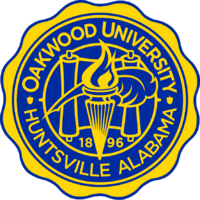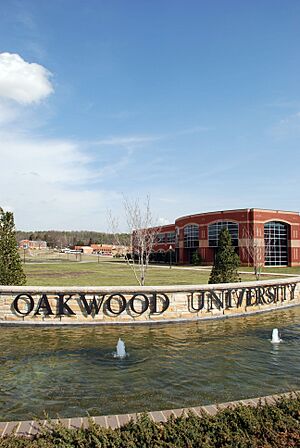Oakwood University facts for kids
 |
|
|
Former names
|
Oakwood Industrial School (1896–????) Oakwood Manual Training School (????–1917) Oakwood Junior College (1917–1932) Oakwood College (1932–2008) |
|---|---|
| Motto | Education, Excellence, Eternity |
| Type | Private, HBCU |
| Established | 1896 |
|
Religious affiliation
|
Seventh-day Adventist Church |
| Endowment | $15.6 million |
| President | Gina Spivey-Brown |
| Undergraduates | 1,810 |
| Location |
,
,
U.S.
34°45′22″N 86°39′11″W / 34.756°N 86.653°W |
| Campus | Suburban, 1,185 acres (480 ha) |
| Colors | Blue & Gold |
| Nickname | Ambassadors |
|
Sporting affiliations
|
NAIA – HBCUAC |
| Mascot | The Ambassador |
 |
|
Oakwood University is a private university in Huntsville, Alabama. It is a special kind of school called a Historically Black College or University (HBCU). It is also connected to the Seventh-day Adventist Church. Oakwood is the only HBCU that the Seventh-day Adventist Church owns and runs.
This university is officially recognized to give out different types of college degrees. These include associate, bachelor's, and master's degrees. Oakwood University also has its own Christian radio station, WJOU 90.1 FM.
Contents
History of Oakwood University
How Oakwood University Started
Oakwood University began after the American Civil War. At that time, many African Americans in the South had just gained their freedom. There was a big effort to create schools for them. A group from the General Conference of Seventh-day Adventists decided to buy land for a school. They wanted to offer job training and spiritual guidance to African American students.
In January 1896, they bought a 360-acre plantation for $6,700. This land had once been owned by the people who enslaved Dred Scott. That same year, Oakwood University was founded. It was first called Oakwood Industrial School.
The school was named after the many oak trees around it. Students had to work on campus to help pay for their schooling. Boys worked in the machine shop and on the farm. Girls worked in the print shop, laundry, and tailor shop. Classes started in November 1896 with 16 students.
Solon Marquis Jacobs was the first principal in 1896. Later, in 1917, James Irving Beardsley became the first president. By 1917, the school taught theology (the study of religion). It also offered programs for jobs like farming, teaching, masonry, and pre-nursing. Before 1917, the school changed its name a few times. It was called Huntsville Training School and Oakwood Manual Training School. Then it became Oakwood Junior College.
Students Standing Up for Change
In 1931, students at Oakwood were unhappy with some things at the school. They had to work very long hours for low pay. Their heavy workloads made it hard to earn enough school credits. There was also racial segregation on campus. Students went on strike to ask for better conditions. They wanted more liberal arts programs and more African American teachers. They also wanted an African American president.
In 1932, the students held rallies and sent a letter to the General Conference. Because of their actions, more African Americans were hired as teachers at Oakwood. This made most of the teachers African American. The General Conference then asked James L. Moran to be president. He became Oakwood's first African American president. Under President Moran, Oakwood became a four-year college and was renamed Oakwood College.
Oakwood and the Civil Rights Movement
The Seventh-day Adventist Church had some strict ideas. Because of this, students at Oakwood were not very involved in the American civil rights movement at first. The church leaders told teachers not to get involved in the movement.
However, in 1962, Oakwood hosted Martin Luther King Jr. He was a guest speaker, and Oakwood was the only place in Huntsville that would host him. After this, some Oakwood students became more active in the movement.
Students at Oakwood were often separated from students at other schools. They also had limited access to news like radio and TV. This made it harder for them to know what was happening with the civil rights movement.
Even with these challenges, students found ways to get involved. They listened to a local Black-owned radio station, WEUP. Some male students joined sit-ins, prayer-ins, and marches. They also took part in store boycotts. They tried to integrate local white Seventh-day Adventist churches. But they faced hostility from people who supported segregation. White church officials even called the police to remove Black students.
Despite the church's efforts to stop them, some male Oakwood students formed groups. They worked with students from Alabama A&M University. They also formed their own small groups. These groups tried to get service at places in Huntsville that only served white people.
Growth and Recognition
Oakwood started with 16 students in 1896. By 1917, it had over 100 students, and by 1927, over 200.
The school first received official recognition as a junior college in 1943. The first bachelor's degrees were given out in 1945.
Between 1958 and 1963, Oakwood worked to become a fully recognized senior college. It joined the United Negro College Fund in 1964.
By 1974, Oakwood's student number reached over 1,000. From 1973 to 1982, the number of graduates grew from 124 to 200.
By 2003, Oakwood offered many different types of degrees. About 1,700 students attended, coming from 38 countries.
In 2008, Oakwood College changed its name to Oakwood University. It was also approved to offer a master's degree in religion. That same year, student numbers grew to 1,865. Students came from 42 U.S. states and 30 countries. By fall 2012, the number of students reached 2,019.
In 2014, Oakwood was approved to change its main church sponsor. It moved from the General Conference to the North American Division of Seventh-day Adventists.
In 2016, Oakwood received full accreditation from the Adventist Accrediting Association. This means it is fully recognized as a quality university.
Academics and Learning
Oakwood University offers degrees for both undergraduate and graduate students. These degrees are offered through different schools:
- School of Arts & Sciences
- School of Business & Information Systems
- School of Education & Social Sciences
- School of Nursing & Health Professions
- School of Theology
In 2004, Oakwood started working with a company called Science Applications International Corp. (SAIC). They partnered to help with wireless technology at Oakwood. This partnership helped Oakwood students get internships and jobs in STEM (Science, Technology, Engineering, and Math) and business. It also supported the space industry.
In 2009, Oakwood was the first HBCU to sign a special agreement with NASA's Mentor-Protégé program through SAIC. This agreement helped Oakwood with technology, managing contracts, and business. It also offered technical and engineering internships to students. By 2015, Oakwood had similar agreements with other big companies like Boeing, Leidos, and Honeywell.
Student Life and Activities
Oakwood University has over 30 clubs and organizations for students.
Musical Groups
The Aeolians are Oakwood University's main touring choir. They were started in 1946 by Dr. Eva B. Dykes. This choir has 45–60 members and travels around the country and the world. They act as musical ambassadors for the university. The choir has performed at the White House for President Bill Clinton and at the Kennedy Center.
Other musical groups on campus include gospel choirs like Dynamic Praise and Voices of Triumph. The group Serenity won the first season of "Making The Group" reality show. Oakwood University is well-known for its great music. In 2010, a vocal group from Oakwood called Committed won the a cappella TV competition The Sing-off. In 2017, The Aeolians were named Choir of the World at a music festival in Wales. The group also appears in Jacob Collier's 2019 recording of Lionel Richie's song "All Night Long (All Night)".
Academic Competitions
At the 2008 Honda Campus All-Star Challenge National Championship Tournament, Oakwood University's team won the trophy. This competition included 64 teams from HBCUs across the nation. Oakwood also received a $50,000 grant. Both the quiz bowl and basketball teams changed their game schedules so they would not play on Saturday. This is because Saturday is observed as the Sabbath at Oakwood. Even with this, both teams won their championships.
At the 2009 Honda Campus All-Star Challenge, the team won again. In 2017, Oakwood won the HCASC Tournament for the third time. They did not lose a single game in the whole tournament. Oakwood is one of only a few schools to win back-to-back championships at HCASC.
Athletics
Oakwood's sports teams are called the Ambassadors (men) and Lady Ambassadors (women). The university is part of the National Association of Intercollegiate Athletics (NAIA). They mainly compete in the HBCU Athletic Conference (HBCUAC) since the 2022–23 school year. Before that, they were part of the United States Collegiate Athletic Association (USCAA).
Oakwood has five main college sports teams:
- Men's teams: baseball, basketball, and soccer
- Women's teams: basketball, soccer, softball, and volleyball
Men's Basketball
The Ambassadors men's basketball team won the 2008 USCAA National Championship. This was in their first season in the association. They won their second USCAA Division I National Championship in March 2012. Their third championship came in March 2016. Oakwood became the first college in Alabama to win three men's basketball championships. The Ambassadors won their fourth title in 2019.
Principals and Presidents
Here is a list of the leaders of Oakwood University. Those who served before 1917 were called principals. After that, they were called presidents.
- Solon Marquis Jacobs, 1896–1897
- Henry S. Shaw, 1897–1899
- Benn Eugene Nicola, 1899–1904
- Fred R. Rogers, 1904–1905
- Granville H. Baber, 1905–1906
- Walter James Blake, 1906–1911
- Clarence Jesse Boyd, 1911–1917
- James I. Beardsley, 1917–1923
- Joseph A. Tucker, 1923–1932
- Frank Loris Peterson, 1945–1954
- Garland Jefferson Millet, 1954–1963
- Addison Vastapha Pinkney, 1963–1966
- Frank W. Hale Jr., 1966–1971
- Calvin B. Rock, 1971–1985
- Benjamin F. Reaves, 1985–1996
- Delbert W. Baker, 1996–2010
- Leslie N. Pollard, 2010–2025
- Gina Spivey-Brown, 2025-present
Notable Alumni
Many successful people have graduated from Oakwood University. Here are a few:
- Delbert Baker (1975) – An administrator, educator, and author. He was a former president of Oakwood University.
- Barry Black – A former U.S. Navy Chief of Chaplains and Chaplain of the U.S. Senate.
- Angela Brown – A soprano opera singer.
- Alvin Chea – A member of the gospel music group Take 6.
- Clifton Davis – An actor, pastor, singer, and songwriter.
- T. R. M. Howard (1931) – A Civil Rights Leader, surgeon, and entrepreneur.
- Heather Knight (1982) – The President of Pacific Union College.
- Davido – A Nigerian Afropop musician.
- Brian McKnight – An R&B singer and musician.
- Claude McKnight – A member of the gospel music group Take 6.
- Wintley Phipps – A pastor, singer, and founder of the U.S. Dream Academy.
- John F. Street – A former mayor of Philadelphia, Pennsylvania.
- Mervyn Warren – A member of the gospel music group Take 6.
- Committed – Winners of Season 2 of NBC's The Sing Off.
- Amber Bullock (2011) – Winner of Season 4 of BET's Sunday Best.
- Little Richard – An American recording artist, singer-songwriter, and actor.
- Eric Thomas (2001) – A pastor, motivational speaker, author, and educator.
- Sydney Freeman Jr. – An educational theorist, author, and social scientist.
See also
- List of Seventh-day Adventist colleges and universities
- List of historically black colleges of the United States
- Seventh-day Adventist education


